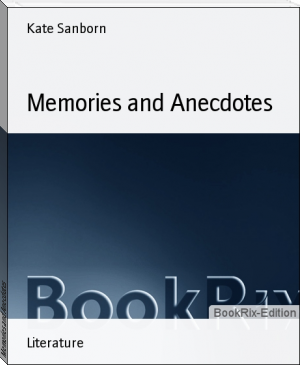Anecdotes of Painters, Engravers, Sculptors and Architects and Curiosities of Art (Vol. 3 of 3), S. Spooner [e novels for free .TXT] 📗

- Author: S. Spooner
Book online «Anecdotes of Painters, Engravers, Sculptors and Architects and Curiosities of Art (Vol. 3 of 3), S. Spooner [e novels for free .TXT] 📗». Author S. Spooner
whence he was called Rembrandt van Rhyn, though his family name was
Gerretz. It is said that his father, being in easy circumstances,
intended him for one of the learned professions, but was induced by
Rembrandt's passion for the art to allow him to follow his inclination.
He entered the school of J. van Zwaanenberg at Amsterdam, where he
continued three years, and made such surprising progress as astonished
his instructor. Having learned from Zwaanenberg all he was capable of
imparting, he next studied about six months with Peter Lastmann, and
afterwards for a short time with Jacob Pinas, from whom it is said he
acquired that taste for strong contrasts of light and shadow, for which
his works are so remarkable. He was, however, more indebted for his best
improvement to the vivacity of his own genius, and an attentive study of
nature, than to any information he derived from his instructors. On
returning home, he fitted up an attic room, with a skylight, in his
father's mill, for a studio, where he probably pursued his labors for
several years, as he did not remove to Amsterdam till 1630. Here he
studied the grotesque figure of the Dutch boor, or the rotund contour of
the bar-maid of an ale house, with as much precision as the great
artists of Italy have imitated the Apollo Belvidere, or the Medicean
Venus. He was exceedingly ignorant, and it is said that he could
scarcely read. He was of a wayward and eccentric disposition, and sought
for recreation among the lowest orders of the people, in the amusements
of the ale-house, contracting habits which continued through life; even
when in prosperous circumstances, he manifested no disposition to
associate with more refined and intellectual society. It will readily be
perceived that his habits, disposition, and studies could not conduct
him to the noble conceptions of Raffaelle, but rather to an exact
imitation of the lowest order of nature, with which he delighted to be
surrounded. The life of Rembrandt is much involved in fable, and in
order to form a just estimate of his powers, it is necessary to take
these things into consideration. It is said by some writers, that, had
he studied the antique, he would have reached the very perfection of the
art, but Nieuwenhuys, in his review of the Lives and Works of the most
eminent painters of the Dutch and Flemish schools, in Smith's Catalogue
raisonné, vol xii. and supplement, says that he was by no means
deficient on that point. "For it is known that he purchased, at a high
price, casts from the antique marbles, paintings, drawings, and
engravings by the most excellent Italian masters, to assist him in his
studies, and which are mentioned in the inventory of his goods when
seized for debt."
He then goes on to give a list of the works so seized. Be this as it may
he certainly never derived any advantage from them. He had collected a
great variety of old armor, sabres, flags, and fantastical vestments,
ironically terming them his antiques, and frequently introducing them
into his pictures.
Rembrandt had already brought both the arts of painting and engraving to
very great perfection (in his own way), when a slight incident led him
to fame and fortune. He was induced by a friend to take one of his
choicest pictures to a picture-dealer at the Hague, who, being charmed
with the performance, instantly gave him a hundred florins for it, and
treated him with great respect. This occurrence served to convince the
public of his merit, and contributed to make the artist sensible of his
own abilities. In 1630 he went to Amsterdam, where he married a handsome
peasant girl (frequently copied in his works), and settled there for
life. His paintings were soon in extraordinary demand, and his fame
spread far and wide; pupils flocked to his studio, and he received for
the instruction of each a hundred florins a year. He was so excessively
avaricious that he soon abandoned his former careful and finished
style, for a rapid execution; also frequently retouched the pictures of
his best pupils, and sold them as his own. His deceits in dating several
of his etchings at Venice, to make them more saleable, led some of his
biographers to believe that he visited Italy, and resided at Venice in
1635 and 1636; but it has been satisfactorily proved that he never left
Holland, though he constantly threatened to do so, in order to increase
the sale of his works. As early as 1628, he applied himself zealously to
etching, and soon acquired great perfection in the art. His etchings
were esteemed as highly as his paintings, and he had recourse to several
artifices to raise their price and increase their sales. For example, he
sold impressions from the unfinished plates, then finished them, and
after having used them, made some slight alterations, and thus sold the
same works three or four times; producing what connoisseurs term
_variations_ in prints. By these practices, and his parsimonious manner
of living, Rembrandt amassed a large fortune.
REMBRANDT'S WORKS.
His works are numerous, and are dispersed in various public and private
collections of Europe; and when they are offered for sale they command
enormous prices. There are eight of his pictures in the English National
Gallery; one of these, the Woman taken in Adultery, formerly in the
Orleans collection, sold for £5000. In Smith's Catalogue raisonné is a
description of six hundred and forty pictures by him, the public and
private galleries and collections in which they were located at the time
of the publication of the work, together with a copious list of his
drawings and etchings, and much other interesting information. He left
many studies, sketches, and drawings, executed in a charming style,
which are now scarce and valuable.
REMBRANDT AS AN ENGRAVER.
Rembrandt holds a distinguished rank among the engravers of his country;
he established a more important epoch in this art than any other master.
He was indebted entirely to his own genius for the invention of a
process which has thrown an indescribable charm over his plates. They
are partly etched, frequently much assisted by the dry point, and
occasionally, though rarely, finished with the graver; evincing the most
extraordinary facility of hand, and displaying the most consummate
knowledge of light and shadow. His free and playful point sports in
picturesque disorder, producing the most surprising and enchanting
effects, as if by accident; yet an examination will show that his
motions are always regulated by a profound knowledge of the principles
of light and shadow. His most admirable productions in both arts are his
portraits, which are executed with unexampled expression and skill. For
a full description of his prints, the reader is referred to Bartsch's
Peintre Graveur.
His prints are very numerous, yet they command very high prices. The
largest collection of his prints known, was made by M. de Burgy at the
Hague, who died in 1755. This collection contained 665 prints with their
variations, namely, 257 portraits, 161 histories, 155 figures, and 85
landscapes. There are no less than 27 portraits of Rembrandt by himself.
ANECDOTE OF SCHWARTS.
Sandrart relates the following anecdote of Christopher Schwarts, a
famous German painter, which, if true, redounds more to his ingenuity
than to his credit. Having been engaged to paint the ceiling of the Town
Hall at Munich by the day, his love of dissipation induced him to
neglect his work, so that the magistrates and overseers of the work were
frequently obliged to hunt him out at the cabaret. As he could no longer
drink in quiet, he stuffed an image of himself, left the legs hanging
down between the staging where he was accustomed to work, and sent one
of his boon companions to move the image a little two or three times a
day, and to take it away at noon and night. By means of this deception,
he drank without the least disturbance a whole fortnight together, the
inn-keeper being privy to the plot. The officers came in twice a day to
look after him, and seeing the well known stockings and shoes which he
was accustomed to wear, suspected nothing wrong, and went their way,
greatly extolling their own convert, as the most industrious and
conscientious painter in the world.
JACQUES CALLOT.
This eminent French engraver was born at Nancy, in Lorraine, in 1593. He
was the son of Jean Callot, a gentleman of noble family, who intended
him for a very different profession, and endeavored to restrain his
natural passion for art; but when he was twelve years old, he left his
home without money or resources, joined a company of wandering
Bohemians, and found his way to Florence, where some officer of the
court, discovering his inclination for drawing, placed him under
Cantagallina. After passing some time at Florence, he went to Rome,
where he was recognized by some friends of his family, who persuaded him
to return to his parents. Meeting with continual opposition, he again
absconded, but was followed by his brother to Turin, and taken back to
Nancy. His parents, at length finding his love of art too firmly
implanted to be eradicated, concluded to allow him to follow the bent of
his genius, and they sent him to Rome in the suite of the Envoy from the
Duke of Lorraine to the Pope. Here he studied with the greatest
assiduity, and soon distinguished himself as a very skillful engraver.
From Rome he went to Florence, where his talents recommended him to the
patronage of the Grand Duke Cosmo II., on whose death he returned to
Nancy, where he was liberally patronized by Henry, Duke of Lorraine.
When misfortune overtook that prince, he went to Paris, whither his
reputation had preceded him, where he was employed by Louis XIII. to
engrave the successes of the French arms, particularly the siege of the
Isle de Ré, in sixteen sheets; the siege of Rochelle, do.; and the siege
of Breda, in eight sheets. His prints are very numerous, and are highly
esteemed; Heineken gives a full list of his prints, amounting to over
fifteen hundred! The fertility of his invention and the facility of his
hand were wonderful; yet his prints are accurately designed. He
frequently made several drawings for the same plate before he was
satisfied. Watelet says that he saw four different drawings by him for
the celebrated Temptation of St. Anthony. His drawings are also greatly
admired and highly prized.
CALLOT'S PATRIOTISM.
When Cardinal Richelieu desired Callot to design and engrave a set of
plates descriptive of the siege and fall of his native town, he promptly
refused; and when the Cardinal peremptorily insisted that he should do
it, he replied, "My Lord, if you continue to urge me, I will cut off the
thumb of my right hand before your face, for I never will consent to
perpetuate the calamity and disgrace of my sovereign and protector."
INGENUITY OF ARTISTS.
Pliny asserts that an ingenious artist wrote the whole of the Iliad on
so small a piece of parchment that it might be enclosed within the
compass of a nut-shell. Cicero also records the same thing. This
doubtless might be done on a strip of thin parchment, and rolling it
compactly.
Heylin, in his life of Charles I., says that in Queen Elizabeth's time,
a person wrote the Ten Commandments, the Creed, the Pater Noster, the
Queen's name, and the date, within the compass of a penny, which he
presented to her Majesty, together with a pair of spectacles of such an
artificial make, that by their help she plainly discerned every letter.
One Francis Almonus wrote the Creed, and the first fourteen verses of
the Gospel of St. John, on a piece of parchment no larger than a penny.
In the library of St. John's College, Oxford, is a picture of Charles I.
done with a pen, the lines of which contain all the psalms, written in a
legible hand.
"At Halston, in Shropshire, the seat of the Myttons, is preserved a
carving much resembling that mentioned by Walpole in his Anecdotes of
Painting, vol. ii., p. 42. It is the portrait of Charles I., full-faced,
cut on a peach-stone; above, is a crown; his face, and clothes which are
of a Vandyck dress are painted; on the reverse is an eagle transfixed
with an arrow, and round it is this motto: _I feathered this arrow._ The
whole is most admirably executed, and is set in gold, with a crystal on
each side. It probably was the work of Nicholas Bryot, a great graver of
the mint in the time of Charles I."--_Pennant's Wales._
In the Royal Museum at Copenhagen is a common cherry-stone, on the
surface of which are cut two hundred and twenty heads!
A HINT TO JEWELERS.
"When the haughty and able Pope Innocent III. caused Cardinal Langton to
be elected Archbishop of Canterbury in despite of King John, and
compelled him to submit, to appease the latter





Comments (0)